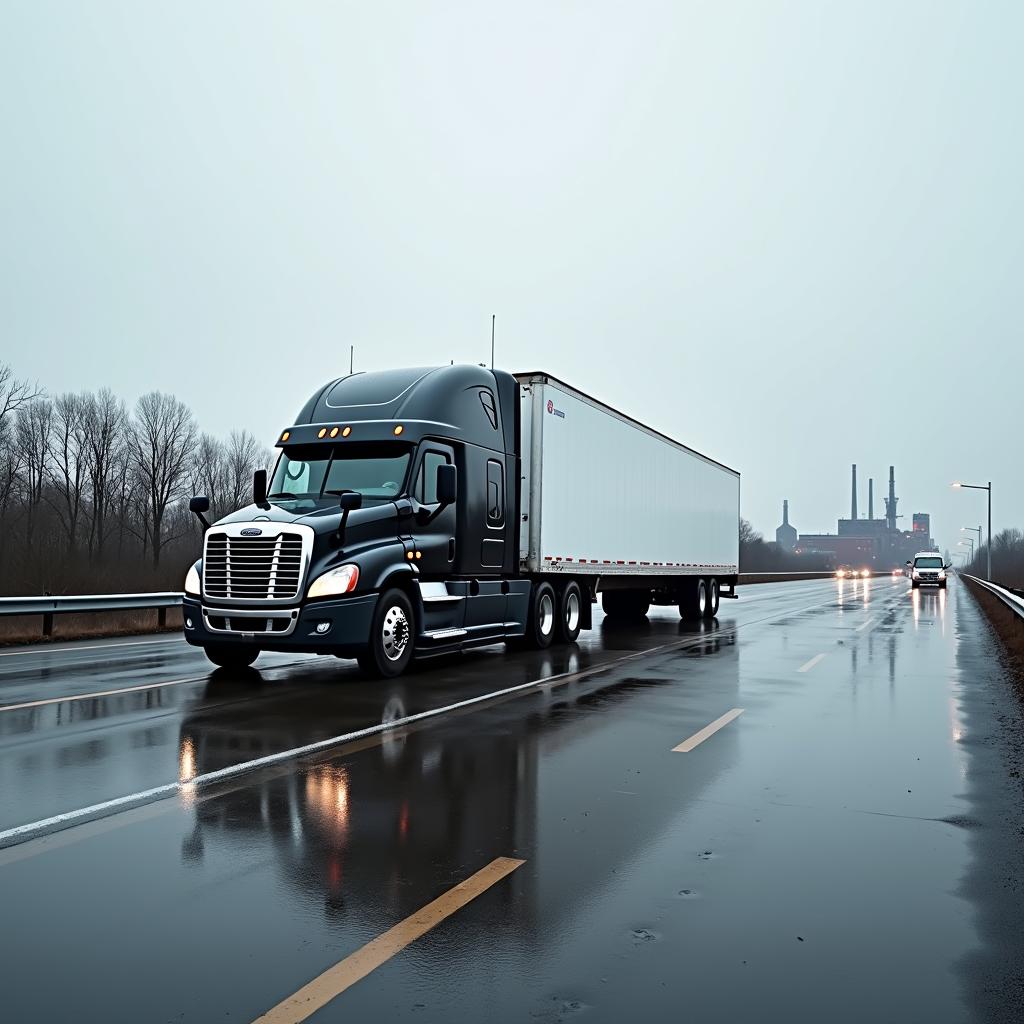Life on the road comes with its unique financial challenges. When those challenges spiral into overwhelming debt, many truckers face the difficult decision of filing for bankruptcy. While this step can provide immediate relief, the journey to financial recovery may seem daunting. Understanding the trucker bankruptcy recovery timeline is essential for those looking to rebuild their financial life after bankruptcy. As professional drivers with specific income patterns and expenses, truckers face unique considerations during this process.
In this comprehensive guide, we’ll walk through the entire bankruptcy recovery journey specifically tailored for truck drivers. From the immediate aftermath of filing to reaching financial stability years later, we’ll cover each milestone and provide practical strategies to accelerate your recovery. Whether you’re contemplating bankruptcy or already navigating its aftermath, this roadmap will help you navigate the road to financial freedom.
Understanding Bankruptcy Basics for Truck Drivers
Before diving into the recovery timeline, it’s important to understand the bankruptcy options available to truck drivers.
Common Bankruptcy Types for Truckers
Truck drivers typically file one of two types of bankruptcy:
- Chapter 7 Bankruptcy: Often called “liquidation bankruptcy,” this option discharges most unsecured debts within 3-6 months. It’s typically chosen by company drivers with limited assets and overwhelming debt.
- Chapter 13 Bankruptcy: This “reorganization bankruptcy” involves a 3-5 year repayment plan. Owner-operators often prefer this option as it can allow them to keep their truck while restructuring their debts.
According to the U.S. Courts, each bankruptcy type affects your credit report differently – Chapter 7 remains for 10 years, while Chapter 13 stays for 7 years. For truckers specifically, understanding these differences is crucial when planning your financial recovery timeline.
Unique Considerations for Truckers
The trucker bankruptcy recovery process involves some industry-specific considerations:
- For owner-operators: Determining what happens to your truck (your livelihood)
- For company drivers: Understanding how bankruptcy affects employment prospects
- For all truckers: Managing irregular income patterns during the recovery phase
With these basics established, let’s examine what the recovery timeline actually looks like for truck drivers.
The First 90 Days After Filing: Immediate Steps in Trucker Bankruptcy Recovery
The initial months after filing bankruptcy are crucial for establishing a solid foundation for your financial recovery. For truck drivers, this period requires careful attention to both personal finances and professional considerations.
Immediately After Discharge (1-30 Days)
Once your bankruptcy is discharged, take these immediate steps:
- Obtain and review your bankruptcy discharge paperwork – Keep these documents in a safe place; you’ll need them when applying for credit and potentially when seeking certain trucking jobs.
- Check your credit reports – Ensure all included debts show “discharged in bankruptcy” status and have zero balances. As a trucker with time constraints, consider using mobile apps that allow you to monitor your credit while on the road.
- Create a post-bankruptcy budget – Account for your trucking income’s unique patterns, including per-mile pay, fluctuations in available loads, and extended time away from home.
For company drivers: Connect with your employer’s HR department to address any concerns about your employment status. Many transportation companies have explicit policies regarding bankruptcy.
For owner-operators: If you kept your truck through the bankruptcy, review your business structure and create a sustainable operational plan.
Building Your Emergency Fund (30-90 Days)
The trucking industry’s volatility makes emergency savings particularly important. In the first 90 days:
- Aim to save at least $1,000 for immediate emergencies
- Open a new savings account specifically for your emergency fund
- Consider automating small transfers from each paycheck
For truckers facing seasonal variations in work, calculate your minimum monthly expenses and work toward saving 3-6 months’ worth over time.
Addressing Essential Trucking Needs
Within the first 90 days, evaluate any essential trucking-related financial needs:
- Insurance requirements – Some insurance providers increase rates after bankruptcy
- Fuel card options – Research secured fuel cards that don’t require perfect credit
- Essential maintenance funds – Establish a separate savings category for inevitable truck maintenance
This early foundation will substantially impact how quickly you progress through the later stages of your bankruptcy recovery journey.
Months 3-12: Rebuilding Credit and Financial Stability
After navigating the immediate post-bankruptcy period, truckers enter a critical phase focused on rebuilding credit and establishing financial stability. This stage typically spans from the third month to the first anniversary of your bankruptcy discharge.
Strategic Credit Rebuilding for Truckers
Credit rebuilding requires a methodical approach:
- Secured credit cards – Apply for a secured credit card with a modest deposit ($200-$500). Use it only for fuel or small purchases you can immediately pay off.
- Credit builder loans – Consider a small credit builder loan specifically designed for post-bankruptcy recovery.
- Monitor progress – Continue checking your credit reports quarterly, focusing on accuracy and gradual score improvements.
Many truckers find that responsible use of fuel cards can also help rebuild their credit, particularly those that report to credit bureaus. Research options from major truck stop chains that offer this benefit.
Establishing Sustainable Financial Habits
This period is crucial for developing habits that prevent future financial difficulties:
- Track expenses meticulously – Use trucker-friendly expense tracking apps that work offline during long hauls
- Build your emergency fund – Continue adding to your emergency savings until you reach at least one month of expenses
- Implement the envelope system – For when you’re home, use cash envelopes for variable spending categories like food and entertainment
Many truck drivers find that tools from the Consumer Financial Protection Bureau can help establish these habits, especially those designed for individuals with irregular income patterns.
Professional Considerations in Your Recovery
During this period, address any lingering professional concerns:
- For owner-operators: Review business expenses and identify areas to increase profitability
- For company drivers: Explore opportunities for additional certifications or specialized hauling that could increase income
- For all truckers: Consider how per diem tax strategies might improve your financial position
By the end of your first year post-bankruptcy, you should have established the fundamental habits and accounts needed for long-term financial recovery.
Years 1-3: Expanding Credit and Planning for the Future
The period between one and three years after bankruptcy represents a significant transition in your trucker bankruptcy recovery journey. During this time, you’ll move from basic credit rebuilding to more advanced financial planning.
Transitioning to Unsecured Credit
With 12+ months of responsible financial behavior, many truckers can begin exploring unsecured credit options:
- Apply for an unsecured credit card – Look for cards marketed to those rebuilding credit, but avoid high-fee, high-interest “subprime” cards
- Consider a small personal loan – A modest loan (perhaps for necessary trucking equipment) can diversify your credit mix
- Gradually increase available credit – Request small credit limit increases on existing accounts every 6-12 months
Remember that the goal isn’t to accumulate debt but to demonstrate your ability to manage different types of credit responsibly. Many truckers find that their credit scores increase significantly during this period, often reaching the 600s or even lower 700s.
Long-Term Financial Planning for Truckers
This period is ideal for implementing longer-term financial strategies:
- Begin retirement planning – Even small contributions to an IRA or 401(k) can grow significantly over time
- Explore health savings accounts (HSAs) – These tax-advantaged accounts can help manage healthcare costs, a concern for many truckers
- Develop a tax strategy – Work with a tax professional familiar with trucking to maximize deductions and minimize tax liability
For owner-operators, this period may include planning for business expansion or equipment upgrades. Company drivers might use this time to evaluate career advancement opportunities or even explore owner-operator possibilities.
Housing Considerations
Many truckers wonder when they can qualify for housing after bankruptcy. Generally:
- Renting: Quality rental options become more available 1-2 years post-bankruptcy
- FHA home loans: Become possible 2 years after Chapter 7 discharge or 1 year after Chapter 13 discharge (with perfect payment history)
- Conventional mortgages: Generally require waiting 4 years after Chapter 7 or 2 years after Chapter 13
For truckers who are frequently on the road, housing decisions may differ from typical consumers. Some choose to maintain minimal housing expenses during this recovery period, investing instead in more comfortable truck amenities since they spend most of their time on the road.
Years 3-7: Achieving Financial Freedom After Trucker Bankruptcy
By years three through seven post-bankruptcy, most truck drivers are experiencing significant improvements in their financial situation. This period typically culminates with the removal of the bankruptcy from credit reports for Chapter 13 filers (at year 7) and nears that milestone for Chapter 7 filers (at year 10).
Maximizing Your Credit Rehabilitation
During this phase, focus on optimizing your credit profile:
- Maintain diverse credit accounts – A healthy mix of revolving credit (cards) and installment loans demonstrates credit management ability
- Keep utilization low – Aim to use less than 30% of available credit, even if limits increase
- Consider becoming an authorized user – If you have a trusted family member with excellent credit, becoming an authorized user on their longstanding account can boost your score
Many truckers see their credit scores reach the “good” to “excellent” range (680-740+) during this period, opening doors to better financial opportunities.
Wealth Building Strategies for Truckers
With improved credit and stable finances, turn your attention to building wealth:
- Increase retirement contributions – Aim to contribute at least 10-15% of your income to retirement accounts
- Consider investment diversification – Beyond retirement accounts, explore other investment vehicles like mutual funds or real estate
- For owner-operators: Evaluate business expansion or fleet growth opportunities
According to research from the National Financial Educators Council, individuals who develop specific financial goals are significantly more likely to achieve financial security. Take time to define specific, measurable goals for this phase of your recovery.
Preparing for Bankruptcy Removal
As the bankruptcy approaches its removal date from your credit report:
- Monitor your credit reports closely – Ensure the bankruptcy is removed at the appropriate time (7 years for Chapter 13, 10 years for Chapter 7)
- Document your recovery journey – Maintain records of your improved financial position
- Consider consulting with a financial advisor – Professional guidance can help maximize opportunities as this major negative item disappears from your credit history
For many truck drivers, this period represents the final chapter in their bankruptcy recovery story and the beginning of true financial freedom.
Conclusion: Your Road to Financial Recovery
The trucker bankruptcy recovery timeline represents a journey from financial distress to stability and prosperity. While the path may seem long—spanning from immediate post-bankruptcy steps through years of rebuilding—each phase presents opportunities for progress. As a truck driver, your unique income patterns and professional considerations require tailored approaches, but the fundamental principles of financial recovery remain consistent: rebuild credit responsibly, establish emergency savings, develop sustainable habits, and gradually work toward long-term financial goals.
Remember that this journey isn’t just about recovering what was lost, but about building a stronger financial foundation than you had before. Many truckers emerge from bankruptcy with improved financial literacy, better money management skills, and a clearer vision for their financial future. The discipline required for successful bankruptcy recovery often translates into greater financial success in the long run.
If you’re a truck driver currently navigating bankruptcy or its aftermath, take heart in knowing that thousands have successfully traveled this road before you. With patience, discipline, and strategic planning, you can transform this challenging period into the beginning of a more secure financial future.
Ready to accelerate your financial recovery after bankruptcy? Our team specializes in helping truck drivers rebuild their financial lives after bankruptcy. We understand the unique challenges you face and have developed strategies specifically tailored to the trucking industry. Submit our consultation form today, and let us help you navigate the road to financial recovery with confidence and clarity. Your journey to financial freedom starts with a single step—reach out now to begin moving forward.







